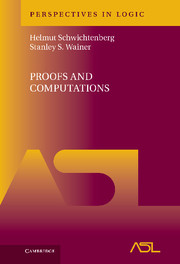Book contents
- Frontmatter
- Contents
- PREFACE
- PRELIMINARIES
- Part 1 Basic proof theory and computability
- Part 2 Provable recursion in classical systems
- CHAPTER 4 THE PROVABLY RECURSIVE FUNCTIONS OF ARITHMETIC
- CHAPTER 5 ACCESSIBLE RECURSIVE FUNCTIONS, ID<ω AND Π-CA0
- Part 3 Constructive logic and complexity
- BIBLIOGRAPHY
- INDEX
CHAPTER 4 - THE PROVABLY RECURSIVE FUNCTIONS OF ARITHMETIC
from Part 2 - Provable recursion in classical systems
Published online by Cambridge University Press: 05 January 2012
- Frontmatter
- Contents
- PREFACE
- PRELIMINARIES
- Part 1 Basic proof theory and computability
- Part 2 Provable recursion in classical systems
- CHAPTER 4 THE PROVABLY RECURSIVE FUNCTIONS OF ARITHMETIC
- CHAPTER 5 ACCESSIBLE RECURSIVE FUNCTIONS, ID AND Π-CA0
- Part 3 Constructive logic and complexity
- BIBLIOGRAPHY
- INDEX
Summary
This chapter develops the classification theory of the provably recursive functions of arithmetic. The topic has a long history tracing back to Kreisel [1951], [1952] who, in setting out his “no-counter-example” interpretation, gave the first explicit characterization of the functions “computable in” arithmetic, as those definable by recursions over standard well-orderings of the natural numbers with order types less than ε0. Such a characterization seems now, perhaps, not so surprising in light of the groundbreaking work of Gentzen [1936], [1943], showing that these well orderings are just the ones over which one can prove transfinite induction in arithmetic, and hence prove the totality of functions defined by recursions over them. Subsequent work of the present authors [1970], [1971], [1972], extending previous results of Grzegorczyk [1953] and Robbin [1965], then provided other complexity characterizations in terms of natural, simply defined hierarchies of so-called “fast growing” bounding functions. What was surprising was the deep connection later discovered, first by Ketonen and Solovay [1981], between these bounding functions and a variety of combinatorial results related to the “modified” finite Ramsey theorem of Paris and Harrington [1977]. It is through this connection that one gains immediate access to a range of mathematically meaningful independence results for arithmetic and stronger theories. Thus, classifying the provably recursive functions of a theory not only gives a measure of its computational power; it also serves to delimit its mathematical power in providing natural examples of true mathematical statements it cannot prove.
- Type
- Chapter
- Information
- Proofs and Computations , pp. 149 - 194Publisher: Cambridge University PressPrint publication year: 2011

